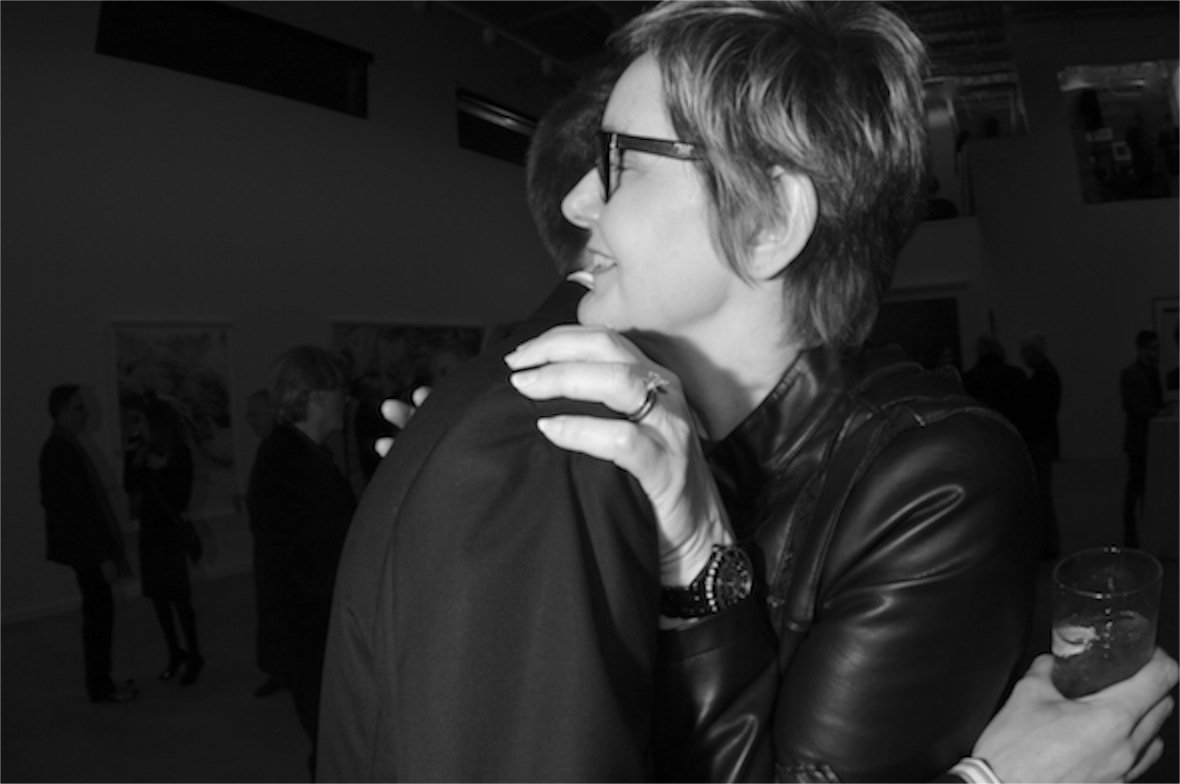February 2013
Steve Litt reviews the Transformer Station opening shows
16/02/13
The Bidwell + Cleveland Museum of Art Transformer Station gallery in Ohio City launches with "Light of Day" and Vaughn Wascovich photos
Light of Day
Bridging Cleveland
Steve Litt, The Plain Dealer
Fred and Laura Bidwell mean business.
By now, it's widely known that the Peninsula-based art collectors and philanthropists have renovated and expanded a 1924 streetcar transformer station in Ohio City on Cleveland's West Side as an architecturally stunning contemporary art gallery.
Their goal is to organize two shows a year based primarily on their growing, nationally respected collection of contemporary photography, which numbers about 700 objects.
Better yet, they have agreed to share the new space with the Cleveland Museum of Art for six months every year, and then eventually to donate the structure to the museum, along with half of their collection. (The other half will go to the Akron Art Museum.)
The urban-development implications of the project are considerable. Valued at $2.5 million to $3 million, the renovation of the Transformer Station has spurred investment in an area developer Graham Veysey calls "Hingetown," where rickety wood-frame houses cluster alongside aging industrial and commercial buildings between Ohio City and the Detroit-Shoreway neighborhood.
This is all great, but two weeks after it opened, it's also clear that the Bidwell project has raised a fascinating artistic question — and that's what really counts over the long haul.
Who will aim higher in quality, edginess and sheer aesthetic brilliance, the museum curators or the Bidwells?
On the basis of the opening pair of exhibitions, produced by the Bidwells, the museum is by no means guaranteed to dominate this artistic tennis match. It will have to work hard to keep up, which is great for art lovers and anyone who cares about Cleveland.
The result of the two opening shows indicates that this will be an artistic conversation held at the highest level.
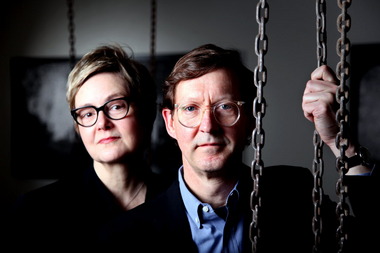
Fred and Laura Bidwell.
Lisa DeJong, The Plain Dealer
The Bidwells' acumen as collectors is well-known in Akron, where the couple has long supported the Akron Art Museum. They exhibited 57 works from their collection in the highly regarded 2008 exhibition "A Shared Vision," and also backed the memorable 2010 exhibition onAndrew Moore's definitive photographs of crumbling, abandoned factories and schools in Detroit. They sponsored the catalog from that exhibition, which became a best seller.
In Cleveland, where Fred Bidwell also serves on the board of the Cleveland Museum of Art, the Bidwells sponsored the catalog to the museum's 2011 exhibition of Brian Ulrich's compelling photographs of shopping and consumerism entitled "Is This Place Great or What."
At the Transformer Station, the Bidwells' opening shows demonstrate a desire for breadth and depth that builds on their earlier projects in Akron and Cleveland.
One show, "Light of Day," offers a broad sample from the Bidwells' extensive collection. The other focuses on new works commissioned for the opening by the Bidwells from Youngstown native Vaughn Wascovich, who teaches photography at Texas A&M University-Commerce.
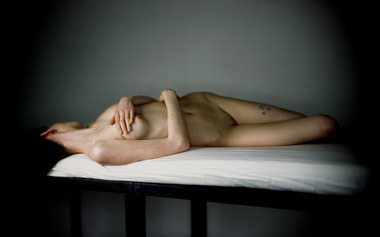
Richard Learoyd's "Phie Nude Front," 2011, flouts typical notions of feminine beauty in an image of luminous vulnerability.
(c) Richard Learoyd, courtesy Fraenkel Gallery, San Francisco
With more than two dozen large images, "Light of Day" combines works by young, up-and-coming talents with respected figures such as Chuck Close, Hiroshi Sugimoto and Adam Fuss.
A variety of approaches are investigated. Beate Gutschow of Germany presents a bucolic scene of picnickers by a riverside that turns out to be a digital confection inspired by 17th-century European landscapists such as Claude Lorrain. The entrancing image keeps you guessing about what's real and what's invented — and how (or whether) it matters.
New Yorker Penelope Umbrico harvested 108 images of sunsets posted by amateur photographers on the website Flickr and grouped them together in a collage that comments on the universal fascination with the sun and how easy it is to "sample" and repurpose content gleaned from the Web.
A 2005 image by Cuban native Abelardo Morell in which the photographer turned a gallery in the Philadelphia Museum of Art into a giant camera obscura is transfixing.
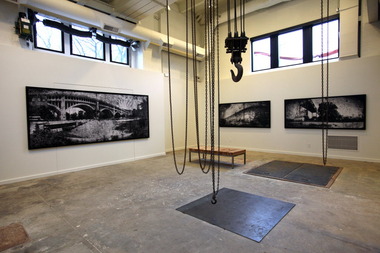
Inside the Vaughn Wascovich show at the Transformer Station.
Lisa DeJong, The Plain Dealer
Morell darkened the room and then allowed light to penetrate from a single point that projected a ghostly, upside-down image of the museum's neoclassical facade over a surreal scene of a city square by Italian Metaphysical painter Giorgio de Chirico. Morell's lengthy exposure strangely makes the image look as if it were made in full daylight.
Other works in the show test the notion of what a photograph might be. Sugimoto of Japan creates an image of a lightning bolt, not with a camera and lens, but by sending high levels of electricity through a large sheet of film.
The overall thrust of "Light of Day" is to emphasize an almost giddy sense of opportunity and possibility within the realm of photography. It's a good start for the Bidwells, and a good first look at their collection.
The Wascovich exhibition, entitled "Bridging Cleveland," focuses on images the artist made by using a large pinhole camera fitted with paper negatives to create portraits of the bridges over the Cuyahoga River in the Flats.
The bridge motif has been done to death in Cleveland, but Wascovich makes it fresh through a process in which he splashed his large-scale prints in the darkroom with chemicals that created splatter patterns that evoke natural processes of rust and decay.
Wascovich's wide-angle images turn the bridges into shapes that curve and swoop, echoing the crooked path of the river over which they soar.
They're present-day equivalents of the ancient Roman ruins chronicled in the 18th-century etchings of Giovanni Battista Piranesi.
This is a familiar and predictable perspective on Cleveland, although Wascovich achieves it with a sense of grandeur and swagger that makes his works feel like the last word on the subject.
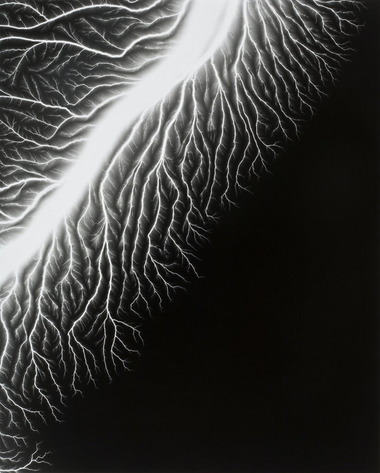
Don't try this at home: Hiroshi Sugimoto's image of lightning shows the results of sending electricity through photographic film.
Hiroshi Sugimoto
The Transformer Station itself, as renovated and enlarged by Cleveland architect John Williams, is gorgeous.
The building features two galleries with 3,000 square feet of space and ceilings ranging from 20 to 22 feet high. The rooms are beautifully proportioned and well-lighted with high, clerestory windows. And inside the original portion of the building, chains and a hook dangle from a 15-ton crane high overhead, lending it a gritty, muscular industrial feel — and a sense that the Transformer Station is a fundamental expression of Cleveland's industrial heritage.
Fred Bidwell, 60, a former art history major at Oberlin College and a retired advertising executive, once dreamed of becoming a fine-art photographer himself. But he realized his talents lay in marketing products for companies such as Kimberly-Clark.
Laura Bidwell, 58, a graphic designer and filmmaker, earned a degree in painting at the University of Akron before joining Malone Advertising in the 1978, where she met her husband-to-be.
For both of the Bidwells, the Transformer Station project represents a new type of activist philanthropy. They're using their wealth to engage in a creative project that benefits the community, rather than turning over their venture to third parties.
The project is similar to that of the collection formed by collectors Donald and Mera Rubell and displayed in a 45,000-square-foot warehouse in Miami, formerly a Drug Enforcement Agency warehouse.
The Rubell family museum is now one of the city's cultural anchors, and, according to the Washington Post, it has set the Wynwood neighborhood "ablaze with color, with murals, art galleries, cafes and top-shelf eateries luring hipsters and big spenders alike."
In Cleveland, the Bidwells plan to continue adding to their collection and to operate the Transformer Station for 15 to 20 years, at which point they'll hand it over to the Cleveland Museum of Art. As the opening volley in this venture, the Bidwells' two exhibitions show that their project is not an empty folly or an exercise in vanity.
It throws down a gauntlet — to the viewer, and to the Cleveland museum — one that quietly asks: How serious are you? How much energy are you willing to put into the Transformer Station, and what might be the result? That's a great question — and one for the entire city to answer.
Light of Day
Bridging Cleveland
Steve Litt, The Plain Dealer
Fred and Laura Bidwell mean business.
By now, it's widely known that the Peninsula-based art collectors and philanthropists have renovated and expanded a 1924 streetcar transformer station in Ohio City on Cleveland's West Side as an architecturally stunning contemporary art gallery.
Their goal is to organize two shows a year based primarily on their growing, nationally respected collection of contemporary photography, which numbers about 700 objects.
Better yet, they have agreed to share the new space with the Cleveland Museum of Art for six months every year, and then eventually to donate the structure to the museum, along with half of their collection. (The other half will go to the Akron Art Museum.)
The urban-development implications of the project are considerable. Valued at $2.5 million to $3 million, the renovation of the Transformer Station has spurred investment in an area developer Graham Veysey calls "Hingetown," where rickety wood-frame houses cluster alongside aging industrial and commercial buildings between Ohio City and the Detroit-Shoreway neighborhood.
This is all great, but two weeks after it opened, it's also clear that the Bidwell project has raised a fascinating artistic question — and that's what really counts over the long haul.
Who will aim higher in quality, edginess and sheer aesthetic brilliance, the museum curators or the Bidwells?
On the basis of the opening pair of exhibitions, produced by the Bidwells, the museum is by no means guaranteed to dominate this artistic tennis match. It will have to work hard to keep up, which is great for art lovers and anyone who cares about Cleveland.
The result of the two opening shows indicates that this will be an artistic conversation held at the highest level.

Fred and Laura Bidwell.
Lisa DeJong, The Plain Dealer
The Bidwells' acumen as collectors is well-known in Akron, where the couple has long supported the Akron Art Museum. They exhibited 57 works from their collection in the highly regarded 2008 exhibition "A Shared Vision," and also backed the memorable 2010 exhibition onAndrew Moore's definitive photographs of crumbling, abandoned factories and schools in Detroit. They sponsored the catalog from that exhibition, which became a best seller.
In Cleveland, where Fred Bidwell also serves on the board of the Cleveland Museum of Art, the Bidwells sponsored the catalog to the museum's 2011 exhibition of Brian Ulrich's compelling photographs of shopping and consumerism entitled "Is This Place Great or What."
At the Transformer Station, the Bidwells' opening shows demonstrate a desire for breadth and depth that builds on their earlier projects in Akron and Cleveland.
One show, "Light of Day," offers a broad sample from the Bidwells' extensive collection. The other focuses on new works commissioned for the opening by the Bidwells from Youngstown native Vaughn Wascovich, who teaches photography at Texas A&M University-Commerce.

Richard Learoyd's "Phie Nude Front," 2011, flouts typical notions of feminine beauty in an image of luminous vulnerability.
(c) Richard Learoyd, courtesy Fraenkel Gallery, San Francisco
With more than two dozen large images, "Light of Day" combines works by young, up-and-coming talents with respected figures such as Chuck Close, Hiroshi Sugimoto and Adam Fuss.
A variety of approaches are investigated. Beate Gutschow of Germany presents a bucolic scene of picnickers by a riverside that turns out to be a digital confection inspired by 17th-century European landscapists such as Claude Lorrain. The entrancing image keeps you guessing about what's real and what's invented — and how (or whether) it matters.
New Yorker Penelope Umbrico harvested 108 images of sunsets posted by amateur photographers on the website Flickr and grouped them together in a collage that comments on the universal fascination with the sun and how easy it is to "sample" and repurpose content gleaned from the Web.
A 2005 image by Cuban native Abelardo Morell in which the photographer turned a gallery in the Philadelphia Museum of Art into a giant camera obscura is transfixing.

Inside the Vaughn Wascovich show at the Transformer Station.
Lisa DeJong, The Plain Dealer
Morell darkened the room and then allowed light to penetrate from a single point that projected a ghostly, upside-down image of the museum's neoclassical facade over a surreal scene of a city square by Italian Metaphysical painter Giorgio de Chirico. Morell's lengthy exposure strangely makes the image look as if it were made in full daylight.
Other works in the show test the notion of what a photograph might be. Sugimoto of Japan creates an image of a lightning bolt, not with a camera and lens, but by sending high levels of electricity through a large sheet of film.
The overall thrust of "Light of Day" is to emphasize an almost giddy sense of opportunity and possibility within the realm of photography. It's a good start for the Bidwells, and a good first look at their collection.
The Wascovich exhibition, entitled "Bridging Cleveland," focuses on images the artist made by using a large pinhole camera fitted with paper negatives to create portraits of the bridges over the Cuyahoga River in the Flats.
The bridge motif has been done to death in Cleveland, but Wascovich makes it fresh through a process in which he splashed his large-scale prints in the darkroom with chemicals that created splatter patterns that evoke natural processes of rust and decay.
Wascovich's wide-angle images turn the bridges into shapes that curve and swoop, echoing the crooked path of the river over which they soar.
They're present-day equivalents of the ancient Roman ruins chronicled in the 18th-century etchings of Giovanni Battista Piranesi.
This is a familiar and predictable perspective on Cleveland, although Wascovich achieves it with a sense of grandeur and swagger that makes his works feel like the last word on the subject.

Don't try this at home: Hiroshi Sugimoto's image of lightning shows the results of sending electricity through photographic film.
Hiroshi Sugimoto
The Transformer Station itself, as renovated and enlarged by Cleveland architect John Williams, is gorgeous.
The building features two galleries with 3,000 square feet of space and ceilings ranging from 20 to 22 feet high. The rooms are beautifully proportioned and well-lighted with high, clerestory windows. And inside the original portion of the building, chains and a hook dangle from a 15-ton crane high overhead, lending it a gritty, muscular industrial feel — and a sense that the Transformer Station is a fundamental expression of Cleveland's industrial heritage.
Fred Bidwell, 60, a former art history major at Oberlin College and a retired advertising executive, once dreamed of becoming a fine-art photographer himself. But he realized his talents lay in marketing products for companies such as Kimberly-Clark.
Laura Bidwell, 58, a graphic designer and filmmaker, earned a degree in painting at the University of Akron before joining Malone Advertising in the 1978, where she met her husband-to-be.
For both of the Bidwells, the Transformer Station project represents a new type of activist philanthropy. They're using their wealth to engage in a creative project that benefits the community, rather than turning over their venture to third parties.
The project is similar to that of the collection formed by collectors Donald and Mera Rubell and displayed in a 45,000-square-foot warehouse in Miami, formerly a Drug Enforcement Agency warehouse.
The Rubell family museum is now one of the city's cultural anchors, and, according to the Washington Post, it has set the Wynwood neighborhood "ablaze with color, with murals, art galleries, cafes and top-shelf eateries luring hipsters and big spenders alike."
In Cleveland, the Bidwells plan to continue adding to their collection and to operate the Transformer Station for 15 to 20 years, at which point they'll hand it over to the Cleveland Museum of Art. As the opening volley in this venture, the Bidwells' two exhibitions show that their project is not an empty folly or an exercise in vanity.
It throws down a gauntlet — to the viewer, and to the Cleveland museum — one that quietly asks: How serious are you? How much energy are you willing to put into the Transformer Station, and what might be the result? That's a great question — and one for the entire city to answer.



